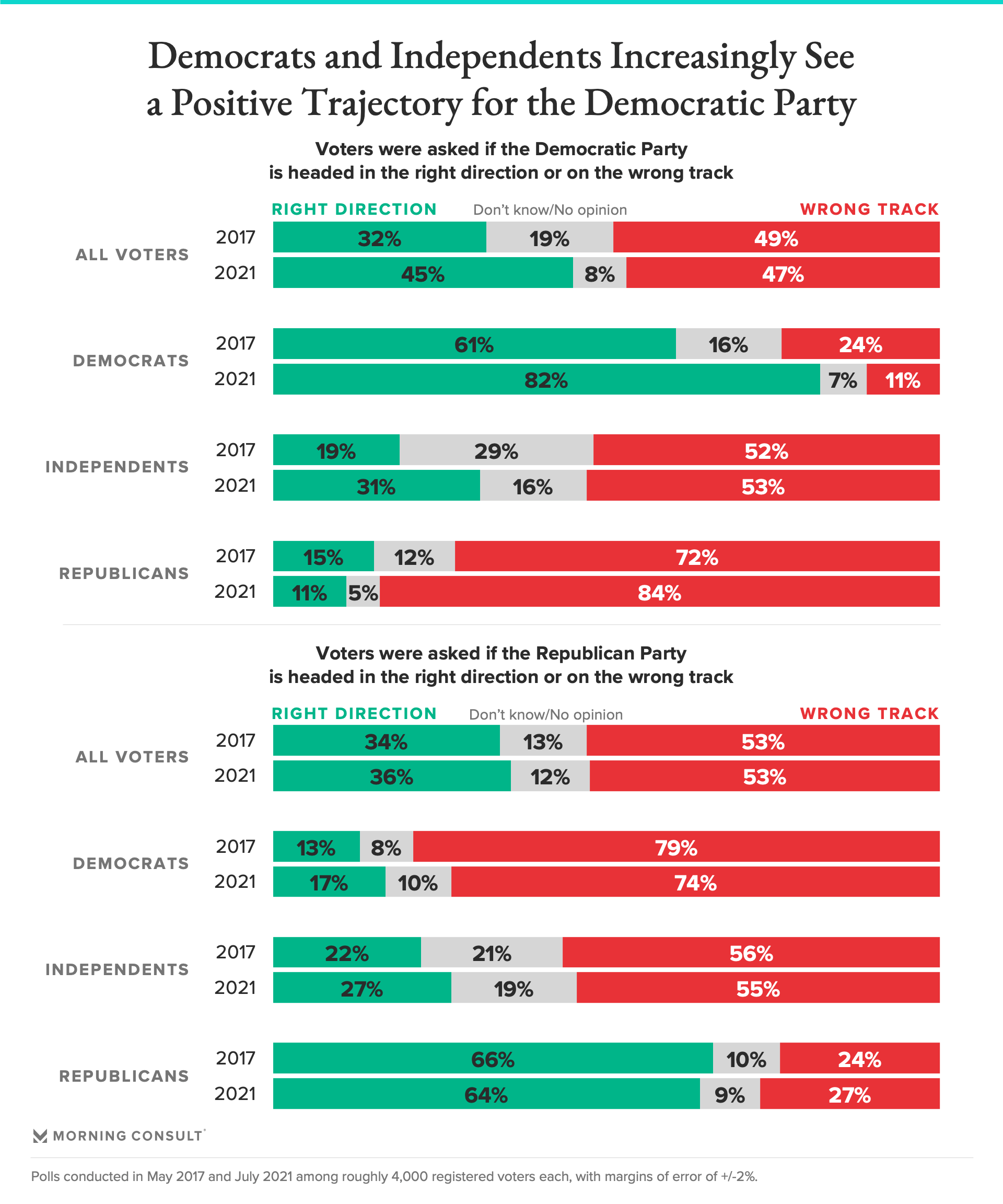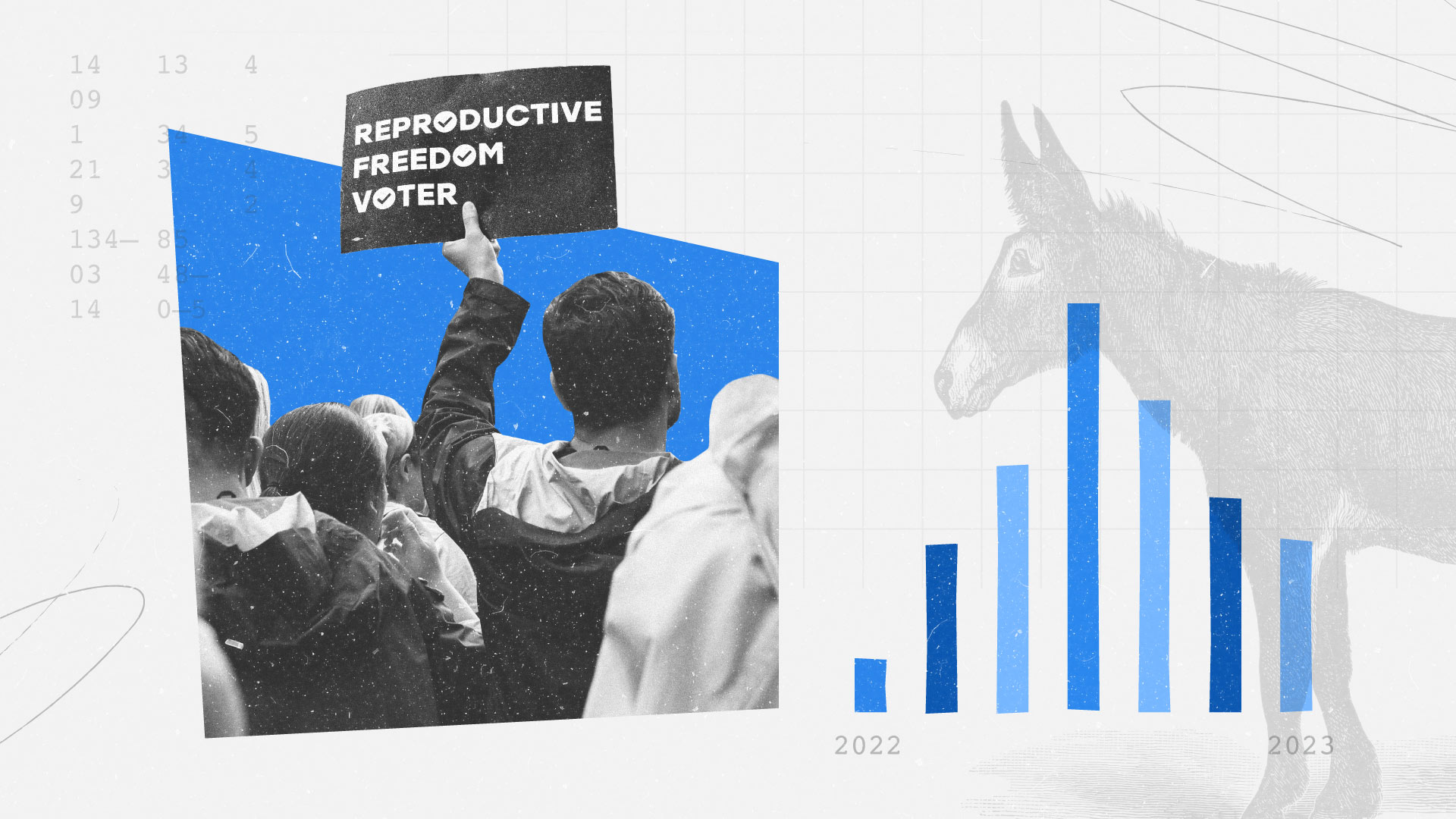Democrats’ Drive to the Left Threatens Their Grip on Power

about this report
This article is part of Morning Consult's standing feature gauging perceptions of America's major political parties. See all of our work here.
Key Takeaways
45% of voters say the Democratic Party is too liberal, up 5 points since 2017, compared with 37% who say the GOP is too conservative, virtually unchanged since the first year of Donald Trump’s presidency.
46% of independents say Democrats are too liberal, compared with 34% who say the Republican Party is too conservative.
45% of voters say the Democratic Party is on the right track, up from 32% four years ago.
The Democratic Party’s leftward trajectory during the Donald Trump era of American politics hasn’t prevented it from regaining full control of the levers of federal power, but yearslong polling trends suggest those priorities may come at an electoral cost in next year’s midterm elections.
While voters are increasingly likely to perceive the Democratic and Republican parties as liberal and conservative, respectively, the electorate is more likely to point the finger at Democrats when it comes to whether the parties have gone too far in their ideological pursuits, according to the latest edition of Morning Consult’s annual State of the Parties survey.
Between 2017 and 2021, the share of registered voters who said the Democratic Party was liberal rose 6 percentage points, from 67 percent to 73 percent. This shift was led by an 11-point increase among independents and a 6-point increase among GOP voters.
Meanwhile, the share of voters who said the Republican Party was conservative rose 8 points during that time (60 percent to 68 percent). That number includes a 9-point increase among GOP voters, to 78 percent, and an 8-point rise among independents to 59 percent.

But while a larger share of the electorate now believes that both parties are embracing their ideological bents, voters are more likely to cast the Democratic Party as “too liberal” than they are to consider the GOP “too conservative,” and the share of voters who say the Republican Party is too far right has changed just 1 point in four years, compared to a 5-point rise in the share who think the Democrats are going too far left.
Forty-five percent of voters, including 46 percent of independents, now say the Democratic Party is “too liberal,” while 37 percent of voters and 34 percent of independents say the GOP has gone too far in the other direction. That 12-point gap among independents is particularly concerning for electoral implications, experts said.
“Even if independents aren't in love with one party's issues and leaders, perceived extremism by the other party could keep those independents in line,” said Nathan Gonzales, a nonpartisan elections analyst who edits and publishes Inside Elections. “Democratic overreach could alienate recently converted voters who are reminded why they voted Republican for the last few decades.”
Perceptions of ideological extremism are all the more worrying given the fronts on which next year’s decisive contests will be fought: competitive suburban-based districts in the House, and on the Senate side, battleground states such as Arizona, Georgia, Pennsylvania and Wisconsin that ran razor-thin margins during the 2020 presidential election.
The poll found that suburban voters — now a critical aspect of the Democratic coalition and pivotal to their success in future elections — were mostly in line with voters overall when it came to perceptions of the parties’ ideologies. Nearly half (47 percent) said Democrats are now too liberal, up from 42 percent in 2017, while 37 percent said the GOP is too conservative, virtually unchanged from four years ago.
“Suburban voters are not very comfortable with the Republican Party under Trump, but they may not be comfortable either with a party that’s really far left on economic issues,” said Stephen K. Medvic, a professor of government and program chair of public policy at Franklin & Marshall College. “The typical suburban voter is pretty liberal on social issues, but they’re pretty moderate to conservative on economic issues, and maybe even the law-and-order kind of issues.”
Ben Koltun, director of research at Beacon Policy Advisors, noted that before President Joe Biden’s election last year, the former vice president — who is perceived as more centrist than much of his party — had been “a welcome presence” in those suburban districts during the 2018 midterm elections.
As he pushes through what Democrats are calling the most ambitious and sweeping progressive agenda since Franklin Delano Roosevelt’s presidency, whether or not Biden retains that moderate perception among voters is likely to play a decisive factor in the congressional makeup for the final two years of Biden’s first term in office.

The four-year trend also brings good news for Democrats. Even as voters -- especially independents -- increasingly see the Democratic Party as too liberal, they’re also more likely to say the party is headed on a positive course. The share of voters overall who said the party is moving in the right direction increased 13 points, from 32 percent to 45 percent, between 2017 and 2021, while the share of independents who said the same rose 12 points (19 percent to 31 percent) during that time.
By comparison, the share of voters who said the GOP was headed in the right direction was virtually unchanged over the past four years, and the share of independents who agreed increased 5 points. Just over half of voters (53 percent) continue to say the Republican Party is on the wrong track, compared to 47 percent who say the same of Democrats.
Cameron Easley is Morning Consult’s head of political and economic analysis. He has led Morning Consult's coverage of politics and elections since 2016, and his work has appeared in The New York Times, The Wall Street Journal, The Washington Post, Politico, Axios, FiveThirtyEight and on Fox News, CNN and MSNBC. Cameron joined Morning Consult from Roll Call, where he was managing editor. He graduated from the University of North Carolina at Chapel Hill. Follow him on Twitter @cameron_easley. Interested in connecting with Cameron to discuss his analysis or for a media engagement or speaking opportunity? Email [email protected].
Morgan Halvorsen is the senior standards editor at Morning Consult. @MorganHalvorsen4
Related content

As Yoon Visits White House, Public Opinion Headwinds Are Swirling at Home

The Salience of Abortion Rights, Which Helped Democrats Mightily in 2022, Has Started to Fade
